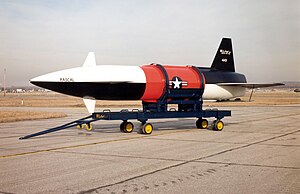GAM-63 RASCAL
| GAM-63 RASCAL | |
|---|---|
 |
|
| Type | Air-to-surface missile |
| Service history | |
| In service | 30 October 1957 (planned) |
| Production history | |
| Manufacturer | Bell Aircraft |
| Unit cost | $2,262,000 |
| Produced | 1952 |
| Specifications | |
| Weight | 18,200 lb (8,255 kg) |
| Length | 31 ft 11.5 in (9.74 m) |
| Diameter | 4 ft (1.22 m) |
| Warhead | W-27 nuclear |
|
Detonation
mechanism |
Airburst or surface |
|
|
|
| Wingspan | 16 ft 8.3 in (5.09 m) |
| Propellant | Bell XLR-67-BA-1 liquid propellant rocket engine with 10,440 lbf (46.4kN) of thrust |
|
Operational
range |
100 miles (161 km) |
| Flight ceiling | 65,000 ft (19,812 m) |
| Speed | 1,950 mph (3,138 km/h) |
|
Guidance
system |
Command guidance with radar imaging (GAM-63) Inertial guidance/Command with radar imaging (GAM-63A) |
|
Launch
platform |
B-36, B-50, and B-47 |
The GAM-63 RASCAL is a supersonic air-to-surface missile that was developed by the Bell Aircraft Company. The RASCAL was the United States Air Force's first nuclear armed standoff missile. The RASCAL was initially designated the ASM-A-2, then re-designated the B-63 in 1951 and finally re-designated the GAM-63 in 1955. The name RASCAL was the acronym for RAdar SCAnning Link, the missile's guidance system. The RASCAL project was cancelled in September 1958.
During World War II, Nazi Germany air-launched 1,176 V-1 missiles from Heinkel He 111 bombers. The United States Army Air Forces (USAAF) studied this weapon system. Testing was conducted in the United States using B-17 bombers and the JB-2 Doodle Bug, a locally produced copy of the V-1. Successful testing of this combination led to the release of requirements to the aerospace industry for an air-to-surface missile on 15 July 1945.
In March 1946 the USAAF began work on Project Mastiff, a nuclear armed air-to-surface drone or self-controlled air-to-surface missile. Northrop Corporation, Bell, and Republic Aviation were invited by the USAAF to submit proposals for Mastiff. Bell was awarded a feasibility study contract by the USAAF on 1 April 1946. Bell studied the feasibility of developing a subsonic "pilot-less" bomber carrying a substantial payload over a distance of 300 miles (480 km).
After 18 months of study, Bell concluded that rocket propulsion was not capable of providing the performance needed to boost the missile the AAF wanted to a range of 300 miles. The range requirement was reduced to 100 miles (160 km) (160.9 km) but other technical problems surfaced.
...
Wikipedia
